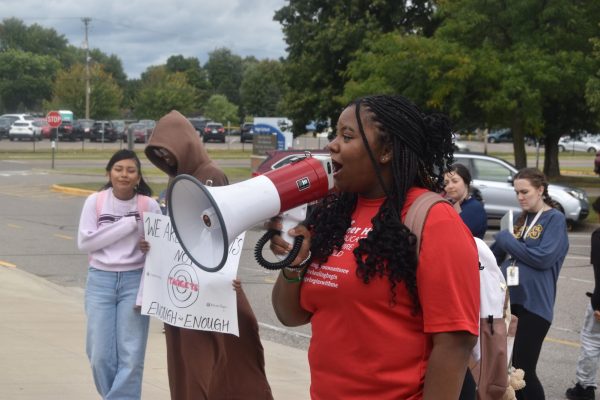Vaccination rates on the rise, economic recovery soon to follow

No matter what brand of vaccine, it’s important that everybody that can gets vaccinated as soon as they can.
The ongoing global COVID-19 pandemic may soon be in the rearview, but that doesn’t change the fact that it has impacted so many people around the world, including in the U.S. Just one of the several factors that still lingers is the rise of unemployment around the country, which has been devastating for families and individuals nationwide.
The U.S. economy has had a devastating recession since the start of the pandemic with a record shrinking of 31.4% during the second quarter of 2020. With the initial nationwide mandate of quarantine and staying at home, businesses were forced to close down, making living space in higher demand as at-home work became a common alternative. Unemployment neared the levels of those during the Great Depression. In April of 2020, unemployment peaked at 14.8%, a number not seen in the U.S. since 1940.
Even with record-high unemployment rates, low interest rates prompted the increase of the house market. Similarly to the Great Depression, many were on the verge of losing their homes.
As a result, the United States passed four laws relating to stimulus spending to relieve both families and businesses struggling throughout the pandemic. The Congressional Budget Office (CBO) stated that the United States’s federal budget deficit would jump to $3.3 trillion in 2020—three times larger than that of the 2019 budget deficit.
The medical, social and economic effects of the pandemic have put pressure on the United States government (as well as other countries) for the approval and distribution of COVID-19 vaccines. President Joe Biden, less than a month into his first term in office, declared his goal of administering 100 million vaccines within 100 days and expanding vaccine supply to Americans in states, Tribes and territories.
In May 2020, President Biden set a new goal of administering at least one dose (of the vaccine) to the 70% of the adult population with 160 million adults fully vaccinated by July 4. According to the U.S. Centers for Disease Control and Prevention, about 56% of the adult population has received one dose of the vaccine thus far.
But what type of COVID-19 vaccines are there? So far, the FDA has authorized three vaccines: Pfizer-BioNTech, Moderna, and Johnson & Johnson.
The Pfizer-BioNTech vaccine contains two doses (shots), 21 days apart; it is an mRNA vaccine — it sends a piece of the genetic code from the SARS CoV-2 virus (also known as coronavirus) to the host cells in the body, in which then creates copies of the virus’ protein and stimulates the immune system. It then creates antibodies and develops memory cells that could recognize the virus if it ever enters the body. As of now, this vaccine is the only one that has been approved for use by 16 and 17-years-olds; a new iteration of the vaccine has been approved for use in 12 to 15-year-olds.
Like the Pfizer-BioNTech vaccine, the Moderna vaccine also contains two doses, and is an mRNA vaccine but doses need to be administered 28 days apart. Research has suggested that the Moderna vaccine can potentially provide protection against other variants of the virus as well.
The Johnson & Johnson vaccine is a bit different, however. It is only one dose and is a carrier vaccine — a harmless adenovirus that has been engineered to carry the genetic code of the spike proteins. Once in the cells, the immune system creates antibodies and memory cells to protect against infection. It usually takes a few weeks for the body to create memory cells (T-lymphocytes and B-lymphocytes) after vaccination, thus having a risk of infection and developing COVID-19 before being fully protected by the vaccine.
There are two other vaccines that have not been approved by the FDA and not available in the United States: the Oxford-AstraZeneca (mainly available in the European Union) and Novavax vaccines (still being studied and in clinical trials).
One of the most dreaded parts of getting vaccinated, without a doubt, are the side effects. Some side effects include: chills, fevers, redness, pain and tiredness. One very very rare, but serious side effect that the Johnson & Johnson vaccine caused as it became available for wide use were blood clots. The clots were rare but severe, manifesting in the blood supply that drains the brain (called Cerebral Venous Sinus Thrombosis), and it has been seen in the combination with low levels of platelets. The clots that have been reported so far have been women between the ages of 18 and 48. To put that in perspective, six women had blood clot reactions from the vaccine and about 7 million people have received the vaccine so far. FDA officials have stated that this type of reaction could potentially be a result of rare autoimmune reactions. The FDA had suggested pausing the use of the vaccine as the side effects should be studied; the Johnson & Johnson vaccine is now, again, available as the benefits outweigh the risk of blood clots and other rare side effects.
In the last year, there has been so much that has happened and changed. The start of the pandemic, the economy falling and the beginning of vaccinations in hopes of a more normal future. According to public policy analyst Alex Arnon from the Penn Wharton Budget Model, the pace of the economic recovery is dependent on the pace of COVID-19 vaccinations.
“Vaccines are also important for large manufacturing industries in the US and around the world; These industries were hard hit because the employees work long hours in close proximity to one another, making them very susceptible to spread disease,” economics teacher at Columbia Heights High School Mr. Dan Tschida said. “The world economy is interconnected, so products in the US depend on many different parts made around the world.”
Currently there have been 276 million people who have received at least one dose; 124 million are fully vaccinated (37.9% of the population).
As herd immunity and more COVID-19 vaccinations occur, the road to economic recovery will be near; However, not even experts know when this will occur; with a completely new disease, it’s hard to identify the percentage needed to achieve herd immunity. The decrease of hospitalizations, deaths, and cases are the only things that could indicate when the population and the economy can fully begin to recover.

Valerie Barrera is a senior at CHHS and a staff writer for The Heights Herald. She is very passionate about writing and bringing people news about entertainment....






